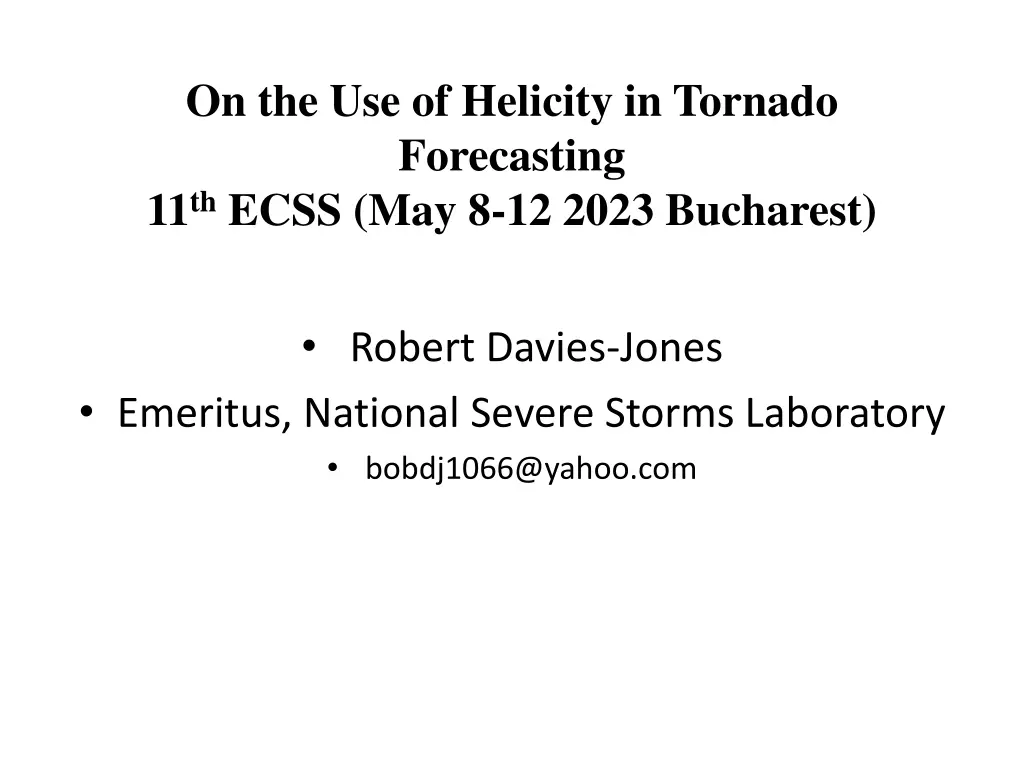
Utilizing Helicity for Tornado Forecasting
Explore the use of helicity in tornado forecasting through the 11th ECSS presentation by Robert Davies-Jones. Understand the significance of parameters like STP and dynamic STP, along with the relationship between storm motion and propagation vectors in supercell theory.
Download Presentation

Please find below an Image/Link to download the presentation.
The content on the website is provided AS IS for your information and personal use only. It may not be sold, licensed, or shared on other websites without obtaining consent from the author. If you encounter any issues during the download, it is possible that the publisher has removed the file from their server.
You are allowed to download the files provided on this website for personal or commercial use, subject to the condition that they are used lawfully. All files are the property of their respective owners.
The content on the website is provided AS IS for your information and personal use only. It may not be sold, licensed, or shared on other websites without obtaining consent from the author.
E N D
Presentation Transcript
On the Use of Helicity in Tornado Forecasting 11thECSS (May 8-12 2023 Bucharest) Robert Davies-Jones Emeritus, National Severe Storms Laboratory bobdj1066@yahoo.com
Theory & forecasting In supercell theory, rotation & propagation are linked: "dynamically induced vertical pressure gradients ... force an updraft to propagate continuously toward a particular flank, thus allowing it to become well correlated with the vertical vorticity on that flank." (JAS 2000, p. 1453) STP is a skillful tornado forecast parameter It varies with storm-relative winds Relies on predicted storm motion = a mean wind vector + a propagation vector (Bunkers et al., W&F 2000, p. 68) Plugging storm motion formula into STP formula STP = mean-wind + propagation parts. In tornado situations, theory says propagation part should be significant. Is it?
Some definitions: Significant Tornado Parameter STP STP < 1 predicts storms are nontornadic Mean STP for supercells with significant tornadoes is 3.4 Dynamic STP = STP with thermodynamic factors =1 (to study just effects of dynamics)
Dynamic STP? Dynamic STP = 0.01 SRH(0,1) x 0.05 BWD Storm-relative helicity is where c is storm motion vector & is vorticity vector (90 left of shear)
Bunkers propagation P & storm motion c for RM? Propagation away from mean wind is where is mean wind from 0 to 6 km AGL Deviation from mean wind is Storm-relative wind decomposes into V' & P:
Amended storm motion To make |P| scale invariant (scale with size of hodograph), set |P| ~0.2 BWD, not 7.5 m/s Amended storm motion is Amended propagation vector is For BWDs herein (35-38 m/s), 0.2 BWD = 7 to 7.6 (close to 7.5) & amended storm motion does not change conclusions
Mean-wind (MWH) & propagation helicity (PH) Insert c formula into SRH formula MWH is SRH if storm moved with mean wind SRH(a,h) = MWH(a,h) + PH(a,h) Layers add: SRH(0,h) = SRH(0,a) + SRH(a,h) MWH(0,1) can dominate PH(0,1) Since BWD is independent of c, STP also decomposes into MWH & PH parts
Formula for PH Performing integration in the PH term results in Substituting for P & specifying layer When S(0,6) is to S(0,1), PH(0,1) is zero. 2 proximity & 7 idealized hodographs show that PH(0,1) < MWH(0,1) in tornado situations
bent hodograph in proximity of violent short-track (9 km) tornado circle is Bunkers mean absolute error (4 m/s) LM orange: SRH(0,1) green: MWH(0,1) magenta: helicity contours H(c) MW B BWD= 38 m/s RM right mover surface more Bunkers mean wind streamwise for RM left mover > 0 0 300 150
long-track (133 km) violent tornado; ~semicircular hodo from 0 to 5 km MW B RM BWD=36 m/s RM surface Bunkers streamwise for RM MW 150 0 300 more
straight, S(z) decreasing straight, S(z) constant least SRH (0,1) & STP surface more streamwise for RMs 90 bend at 1 km, |S(z)| constant 90 bend at 1 km, |S(z)|decreasing most SRH(0,1) & STP BWD = 37.5 m/s
SRH density uniform with height Most STP. Most SRH density near ground 0 6 km semicircles BWD = 35 m/s a) |S(z)| decreasing b) |S(z)| constant c) |S(z)| increasing with z Least STP. Least SRH density near ground surface more streamwise for RMs
(0-1, 1-2, ... , 5-6 km) HELICITIES BY LAYERS for semicircle hodo with decreasing shear PH < MWH SRH Most helicity is in 0-1 layer. Most of this is MWH. 0-1 2-3 1-2
COMPILATION 9 HODOGRAPHS 0 - 1 km 0 - 3 km PH(0,1) = 0.2 S(0,1) S(0,6) is small. PH (blue) << MWH (green) Exception is MWH = 0 for straight hodo 0 - 6 km 100 STP [similar to a)] PH(0,6) = 0.2 BWD2 is substantial.
SUMMARY 1 MWH dominates PH in tornado situations Since I hardly vary BWD, dynamical STP is determined by SRH(0,1) = MWH(0,1) + PH(0,1) For proximity, bent & semicircular hodographs, MWH(0,1) >> PH(0,1). Updrafts would be helical even without propagation. For semicircles, MWH(0,h) >> PH(0,h) for all h For bent hodos, MWH >> PH below bend [& MWH << PH above bend] For unreal straight hodographs (no Ekman layer), MWH = 0 & updraft rotation depends only on PH
SUMMARY 2 STP predicts the following tornado threats: Hodograph-shape effect : Straight = low risk, Bent = moderate risk, Semi-circular = high risk. Shear-profile effect: For hodographs with same shape & BWD, threat increases with concentration of shear magnitude in lowest 1 km But STP fails to predict anticyclonic updraft rotation of left mover (STP should be ve)
SUMMARY 3 Is Bunkers propagation represented in STP? No! Because, in tornado situations, P is nearly || to S(0,1) & STP is then insensitive to prop. speed |P| Two propagation effects not represented in STP: Propagation helicity PH(0,h) is more significant for deeper layers than (0,1). SRH over a deeper layer would make STP < 0 for left mover as expected. Propagation typically makes horizontal vorticity at z = 0 more (less) streamwise for right (left) mover






















